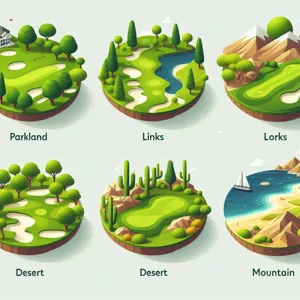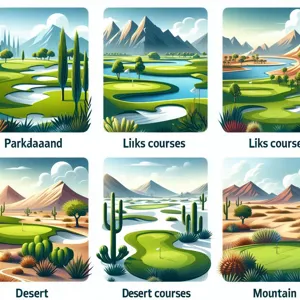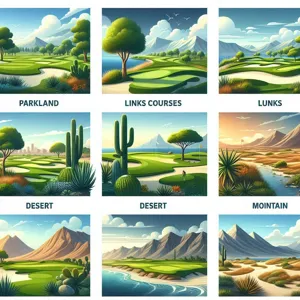Golf is a game steeped in tradition, skill, and the serenity of nature, and the choice of golf course can deeply influence your experience on the links.
From the rolling hills of a classic links course to the meticulously manicured greens of a resort-style layout, each type of golf course offers a unique blend of challenges and beauty. Whether you’re a seasoned golfer looking to expand your horizons or a newcomer eager to understand the nuances of the game, this guide will take you on a journey through the diverse world of golf courses. We’ll explore the distinct characteristics, playing styles, and scenic vistas that define each type, helping you discover the right setting for your next round. So grab your clubs and prepare to tee off as we delve into the fascinating varieties of golf courses and what makes each one special!
1. Introduction to Golf Course Types

Golf is a sport steeped in tradition, yet it offers a diverse array of experiences, largely defined by the type of golf course you choose to play. Understanding the distinctions between various golf course types is essential for golfers of all skill levels, whether you’re a seasoned pro or a curious beginner stepping onto the greens for the first time.
In essence, golf courses can be categorized into several types, each presenting its unique challenges and characteristics. From the lush expanses of public courses—welcoming players of all abilities—to the meticulously maintained fairways of private clubs, the golfing landscape is as varied as the players who traverse it. Links courses, often found along coastlines, offer a rugged charm and unpredictable weather, demanding both skill and adaptability. Meanwhile, resort courses often prioritize scenic beauty and player enjoyment, blending recreation with breathtaking views.
This introduction sets the stage for a deeper exploration into the world of golf courses. We will delve into the features that define each type, the experiences they offer, and how they cater to different styles of play. By the end of this guide, you’ll not only have a clearer understanding of the various golf course types but also feel more equipped to select the perfect course for your next round. So, grab your clubs, and let’s tee off on this journey through the greens!
2. Public vs. Private Golf Courses
When it comes to choosing a golf course, one of the first distinctions to understand is the difference between public and private courses. Each type offers a unique experience, catering to different preferences, budgets, and playing styles.
**Public Golf Courses** are open to everyone, making them an excellent option for golfers of all skill levels. These courses range from basic, no-frills layouts to more elaborate designs, often featuring beautiful landscapes and well-maintained greens. Public courses tend to be more affordable, with lower greens fees and flexible tee times, making them accessible for casual players and those just starting out. They often host tournaments and events, fostering a sense of community among local golfers. However, because they are open to the public, you might find yourself sharing the course with a larger crowd, especially on weekends and holidays.
On the other hand, **Private Golf Courses** offer an exclusive experience, typically requiring a membership for access. These courses often boast superior amenities, including pristine fairways, luxurious clubhouses, and personalized services. The atmosphere at a private course is generally quieter, allowing for a more relaxed round of golf. Membership fees can be substantial, but many golfers find the investment worthwhile for the premium experience and reduced wait times. Private courses often cultivate a strong sense of camaraderie and networking opportunities among members, frequently hosting social events and tournaments that encourage interaction.
Whether you opt for the inclusivity of public courses or the exclusivity of private ones, both types have their merits. Your choice will largely depend on your personal preferences, playing frequency, and budget. Exploring both options can provide a well-rounded golfing experience, allowing you to appreciate the unique qualities that each type of course has to offer.
3. The Charm of Municipal Golf Courses

Municipal golf courses hold a special charm that appeals to golfers of all skill levels and backgrounds. Often nestled within urban landscapes or local parks, these courses are designed to be accessible and welcoming, providing an affordable avenue for the community to engage with the sport. Unlike their more exclusive counterparts, municipal courses exude a sense of camaraderie, where seasoned players and novices alike can share the fairways.
One of the standout features of municipal golf courses is their diversity in layout and design. While some boast challenging holes with intricate hazards, others offer a more relaxed playing experience, perfect for casual rounds with friends or family. This variety means that every visit can provide a new adventure, whether you’re navigating tree-lined fairways or wide-open greens.
Moreover, the atmosphere at a municipal golf course embodies a laid-back vibe that encourages enjoyment over competition. You might find yourself playing alongside a group of locals discussing the latest community events or sharing tips with a newcomer eager to learn. This sense of community enhances the overall experience, making each round not just about the game itself, but about the connections forged along the way.
Many municipal courses also prioritize maintaining the natural beauty of their surroundings, often incorporating local flora and fauna into their landscapes. As you tee off, you might catch glimpses of wildlife or enjoy the tranquility of a nearby pond, making your time on the course feel more like an escape into nature.
In summary, municipal golf courses offer a unique blend of accessibility, community spirit, and natural beauty, making them a beloved choice for golfers seeking both a challenge and a chance to unwind. Whether you’re polishing your swing or simply enjoying a leisurely round, these courses remind us that the heart of golf lies not just in the scorecard, but in the shared experiences and the joy of being outdoors.
4. Championship Golf Courses: What Sets Them Apart
Championship golf courses are the epitome of golfing excellence, designed to challenge even the most skilled players while providing an unforgettable experience for all who step onto their verdant fairways. These courses are often meticulously crafted, featuring a combination of natural landscapes and man-made intricacies that elevate the game to a competitive level.
One of the defining characteristics of a championship golf course is its length. Typically, these courses stretch over 7,000 yards, with strategically placed tees that cater to players of all skill levels. The layout is carefully planned, with each hole designed to test various aspects of a golfer’s game, from accuracy off the tee to precision in approach shots. Expect to encounter a variety of hazards, including water features, strategically positioned bunkers, and challenging roughs that can easily derail even the most seasoned players.
Another hallmark of championship courses is the quality of their greens. These surfaces are meticulously maintained to ensure a fast, true roll, often featuring subtle breaks that can make putting a true test of skill. The undulating terrain and varied grass types add layers of complexity, forcing players to read the greens carefully and adjust their strategies accordingly.
Moreover, championship courses often host professional tournaments, which means they must adhere to strict standards set by governing bodies like the PGA and USGA. This includes everything from the slope rating and course conditions to the overall design and amenities available to players. As a result, many championship courses are equipped with state-of-the-art facilities, including practice ranges, pro shops, and dining options that enhance the overall golfing experience.
In essence, playing a championship golf course is not just about the game; it’s about immersing yourself in a rich tradition of excellence and competition. Whether you’re vying for a personal best or simply enjoying the challenge, these courses provide a unique opportunity to engage with the sport at its highest level. So, when you find yourself on one of these prestigious layouts, take a moment to appreciate the artistry and skill that has gone into creating such a remarkable golfing environment.
5. Resort Golf Courses: Combining Leisure and Play

Resort golf courses offer a unique blend of leisure and play, making them a sought-after destination for both avid golfers and casual players looking to unwind. Nestled within picturesque landscapes, these courses are designed to provide an immersive experience that goes beyond just the game. Picture manicured fairways lined with palm trees, vibrant flowers, and stunning views that stretch over rolling hills or sparkling lakes.
What sets resort golf courses apart is their ability to cater to a diverse clientele. Whether you’re a seasoned golfer seeking a challenging round or a beginner looking for a friendly introduction to the sport, these courses are often equipped to meet your needs. Many resorts feature multiple tee boxes, allowing players of varying skill levels to enjoy the course at their own pace.
Beyond the golf itself, resort courses are typically situated within larger leisure complexes that offer a variety of amenities. After a satisfying round, you can indulge in luxurious spas, gourmet dining, and refreshing pools, creating an all-encompassing retreat. Many resorts also host events, tournaments, and golf schools, providing opportunities to improve your game while mingling with fellow golf enthusiasts.
In addition to the recreational aspects, resort golf courses often emphasize the natural beauty of their surroundings. Many are designed to highlight the area’s unique geography, incorporating native plants and wildlife into their landscapes. This not only enhances the visual appeal but also creates a serene atmosphere that allows players to connect with nature while enjoying their favorite sport.
Whether you’re planning a weekend getaway or a longer vacation, a round at a resort golf course promises a memorable experience that combines the thrill of golf with the relaxation of a holiday retreat. So pack your clubs and prepare for a day where leisure and play harmoniously intertwine.
6. The Allure of Links Courses
### The Allure of Links Courses
Links courses hold a special place in the heart of golf enthusiasts, often revered for their unique blend of natural beauty, challenging terrain, and rich history. Originating in Scotland, where the links land was typically characterized by sandy soil and coastal grasses, these courses are often defined by their proximity to the sea, with rolling hills, undulating landscapes, and a rugged charm that sets them apart from more manicured inland courses.
What makes links courses truly captivating is their integration with the natural environment. The architecture tends to embrace the landscape rather than alter it, showcasing features like deep bunkers, tall grass, and natural hazards that demand strategic play. The winds that sweep off the ocean add another layer of complexity, requiring golfers to think creatively and adapt their game to ever-changing conditions. As you stand on the tee, the salty air fills your lungs, and the sound of crashing waves creates a serene backdrop, immersing you in the experience of the game.
One of the most famous links courses is the Old Course at St Andrews, often referred to as the “Home of Golf.” Here, history and tradition converge, with every hole telling a story of the game’s evolution over centuries. However, links courses aren’t confined to Scotland; they can be found around the world, each offering its own distinctive character and challenges. Whether it’s the dramatic cliffs of Pebble Beach in California or the serene coastlines of Ireland’s Ballybunion, each links course invites golfers to embrace the elements and test their skills in a natural playground.
For those seeking adventure and a connection to the game’s rich heritage, playing a links course is an unforgettable experience. It harks back to the origins of golf, where the fairways were often unkempt, and the game was played in harmony with the land. So, if you’re looking to add a touch of authenticity to your golfing journey, don’t miss the allure of links courses—they promise both a challenge and a journey through the storied past of this beloved sport.
7. Parkland Courses: Nature and Strategy

Parkland courses are a beloved staple in the world of golf, seamlessly blending the beauty of nature with strategic play. These courses are characterized by their lush, tree-lined fairways and carefully manicured greens, often set in a serene, park-like environment. As you step onto a parkland course, you are greeted by a vibrant palette of greenery, where towering trees provide both a picturesque backdrop and a formidable challenge for players.
The layout of parkland courses is designed to encourage thoughtful shot placement and strategic decision-making. The fairways are typically narrow, flanked by dense foliage, which demands precision off the tee. Each hole presents a unique puzzle, enticing golfers to weigh the risks of taking a more aggressive line against the reward of a safer approach. The undulating greens, often surrounded by strategically placed bunkers and water hazards, further elevate the challenge, requiring careful reading of slopes and grain.
Beyond the strategic elements, parkland courses offer an immersive experience in nature. The gentle rustle of leaves, the chirping of birds, and the occasional sighting of wildlife create a tranquil atmosphere that enhances the joy of the game. Many parkland courses are designed to preserve the natural landscape, incorporating native flora that flourishes throughout the seasons, from vibrant wildflowers in spring to the rich hues of autumn.
For golfers seeking a blend of tranquility and mental challenge, parkland courses provide the perfect setting. Whether you are a seasoned player or a newcomer to the game, the combination of nature’s beauty and strategic play ensures that each round is not just a test of skill, but also a refreshing escape into the great outdoors. So next time you’re looking for a course that offers both aesthetic pleasure and a brain-teasing challenge, consider the charm and allure of a parkland course.
8. Desert Golf Courses: Unique Challenges and Landscapes
Desert golf courses offer a striking contrast to the lush, verdant landscapes typically associated with the sport. Set against a backdrop of arid beauty, these courses present unique challenges that test even the most seasoned golfers. Imagine teeing off amidst sweeping vistas of rugged mountains and delicate sand dunes, all under a vast, unyielding sky. The stark beauty of a desert course is captivating, with its palette of earthy browns, vibrant greens, and occasional bursts of wildflowers that bravely color the terrain.
Playing on a desert course is unlike any other golfing experience. The dry conditions often lead to firm fairways and fast greens, requiring players to adjust their technique and strategy. Golf balls can bounce unpredictably off the hard-packed earth, and the absence of trees means that players must contend with swirling winds that can change direction in an instant. Additionally, desert courses are frequently dotted with hazards like cacti and rocky outcrops, adding an extra layer of complexity to each hole.
Moreover, water features, if present, are often man-made and strategically placed, creating both beauty and challenge. Golfers must navigate these elements carefully; a well-placed shot can lead to an easy par, while a miscalculated swing might send a ball tumbling into the desert scrub, where retrieval could prove nearly impossible.
Desert golf courses also encourage a different kind of mindfulness. The expansive views and serene surroundings invite players to slow down and appreciate the environment. Many courses incorporate native flora and fauna into their design, allowing golfers to encounter breathtaking desert wildlife throughout their round. Whether it’s the sight of a hawk soaring above or a lizard darting across the sand, these encounters enrich the golfing experience.
In conclusion, desert golf courses blend natural beauty with challenging gameplay, making them a must-visit for any avid golfer looking to explore diverse landscapes and hone their skills in a distinctive setting. As you prepare for your next golfing adventure, consider venturing into the desert—where every swing offers a new challenge and every hole tells a story.
9. Executive Golf Courses: Shorter Play for All Skill Levels
When it comes to golfing, not everyone has the luxury of time to spend on a full 18-hole course. Enter the executive golf course, a fantastic option that caters to golfers of all skill levels while offering a more accessible and time-efficient play. Typically featuring 9 to 18 holes, these courses are designed with shorter distances, often ranging from 2,000 to 3,500 yards.
Executive courses are perfect for beginners looking to familiarize themselves with the game without the intimidation of lengthy holes and challenging layouts. The shorter format allows new players to experience the joy of golf in a relaxed setting, building confidence and improving their skills as they navigate through each hole. For seasoned golfers, executive courses serve as a great opportunity to practice their short game, honing their putting and chipping skills while enjoying a quicker round.
Many executive courses are designed with a mix of par-3 and par-4 holes, presenting a variety of challenges that keep the game engaging and fun. With the focus on shorter play, these courses often boast a more casual atmosphere, making them ideal for after-work rounds or weekend outings with friends and family. The pace of play is generally faster, meaning you can complete a round in under two hours—perfect for those with busy schedules.
Additionally, executive courses often come with lower green fees, making them an economical choice for casual golfers. This affordability invites more players to the game, fostering a welcoming environment where everyone can enjoy the sport. Whether you’re just starting out, looking to improve your game, or simply seeking a leisurely day outdoors, an executive golf course can provide the perfect setting to enjoy all that golf has to offer. So grab your clubs and hit the green—there’s a whole world of short play waiting for you!
10. Par-3 Courses: Perfect for Beginners and Short Games
Par-3 courses hold a special place in the golfing world, serving as an ideal entry point for beginners and a fantastic venue for seasoned players to sharpen their short game. Typically consisting of nine to eighteen holes, each measuring no more than 200 yards, these courses emphasize precision over power, making them accessible and enjoyable for golfers of all skill levels.
The charm of a par-3 course lies in its simplicity and the unique challenges it presents. With shorter distances, players can focus on their approach shots, putting, and course management without the intimidation of long drives. This makes it the perfect environment for newcomers to learn the fundamentals of the game, such as proper stance, swing mechanics, and club selection, all while enjoying a less overwhelming atmosphere.
Additionally, par-3 courses are often designed with a variety of picturesque holes that can include water hazards, bunkers, and elevation changes, allowing players to experience the beauty of the sport without the time commitment or expense of a full-length course. Many facilities also offer affordable green fees, making them a great option for casual outings with friends or family, or just a quick practice session after work.
For experienced golfers, these courses provide an excellent opportunity to refine short game skills, a critical aspect of lowering one’s handicap. Whether it’s mastering the delicate touch required for chipping or honing putting accuracy, players can work on their technique in a relaxed setting, free from the pressure of a traditional 18-hole course.
In essence, par-3 courses are not just a stepping stone for novices; they are a versatile option for all golfers seeking to improve their skills while enjoying a leisurely day on the links. So, whether you’re picking up a club for the first time or looking to polish your game, consider hitting the greens at your local par-3 course—it might just become your new favorite golfing destination.
11. Understanding Golf Course Design and Layout
Understanding golf course design and layout is crucial for any golfer seeking to enhance their game and appreciate the intricacies of the sport. At its core, a golf course is not just a series of holes strung together on a patch of land; it is a carefully crafted environment that melds artistry with strategy.
Golf course design typically revolves around several key elements: the overall layout, the topography, and the intended level of challenge. Designers often consider the natural landscape, incorporating hills, water hazards, and trees to create a course that not only tests a player’s skills but also offers a visually stunning experience. The layout of a course can vary significantly, ranging from links-style courses with minimal trees and expansive views, to parkland courses that are lush and heavily wooded.
Each hole is meticulously planned, with tee boxes, fairways, and greens designed to encourage specific strategies and shot selections. For example, a par 4 hole may have a narrow fairway that demands precision off the tee, while the green is elevated, requiring a careful approach shot that takes into account wind conditions and elevation changes. Understanding these design nuances can give players a tactical advantage as they navigate the course.
Additionally, golf courses can be categorized into different types based on their design philosophies. Public courses are often designed to accommodate players of all skill levels, featuring wider fairways and accessible greens. In contrast, championship courses may present a more formidable challenge, with strategic bunkering and smaller, more undulating greens that test even the most seasoned golfers.
Ultimately, familiarizing yourself with the design and layout of a golf course not only enhances your appreciation for the game but also empowers you to make smarter decisions on the course. By understanding the intricacies of each hole, you can develop a more strategic approach to your shots, making your round more enjoyable and potentially lowering your scores. Whether you’re a novice or a seasoned player, taking the time to explore the design elements of the courses you play will enrich your golfing experience.
12. Maintenance and Sustainability in Golf Courses
### 12. Maintenance and Sustainability in Golf Courses
The allure of a pristine golf course lies not only in its design and layout but also in the diligent maintenance that keeps it looking its best. Golf course maintenance is a complex blend of artistry and science, where agronomy meets aesthetics. Superintendents and their teams work tirelessly to ensure that greens are smooth, fairways are lush, and hazards remain challenging yet inviting. Regular tasks include mowing, aerating, fertilizing, and pest management, all aimed at promoting healthy turf while minimizing disease and degradation.
However, as environmental concerns gain traction, many courses are shifting towards sustainable practices that promote ecological health. Water conservation is a critical aspect; innovative irrigation systems and drought-resistant grass species help courses maintain their beauty while using resources wisely. Additionally, integrated pest management (IPM) strategies are being adopted to reduce chemical use, focusing instead on natural predators and organic treatments.
Sustainability extends beyond the soil. Many golf courses are becoming more mindful of their land use, implementing programs that promote biodiversity by preserving natural habitats and native plant species. This not only enhances the course’s aesthetic appeal but also contributes positively to local wildlife, creating a balanced ecosystem.
In recent years, some golf courses have even embraced renewable energy sources, installing solar panels and wind turbines to power their facilities. These initiatives not only reduce carbon footprints but also showcase a commitment to responsible stewardship of the environment.
As golf enthusiasts, recognizing the importance of maintenance and sustainability can enhance your appreciation of the game. The next time you tee off, consider the efforts behind the scenes that ensure your experience is not only enjoyable but also environmentally conscious. Each putt on a well-maintained green reflects the dedication to both the sport and the planet.
13. Tips for Choosing the Right Course for Your Game
Choosing the right golf course can significantly enhance your playing experience and help you develop your skills on the greens. With a plethora of options available, from sprawling championship layouts to quaint, nine-hole gems, it’s essential to consider several factors to ensure you select a course that aligns with your game and goals.
First, assess your skill level. Beginners may feel overwhelmed by the challenges presented by a championship course with its long fairways and tricky hazards. Instead, seek out courses designed for novices, featuring shorter holes and forgiving layouts that encourage learning and confidence-building. Conversely, seasoned players may thrive on the complexities offered by more demanding courses, where strategic shot placement and course management come into play.
Next, consider the course’s layout and design. Some golfers prefer a links-style course with its natural terrain, rolling dunes, and coastal breezes, while others might be drawn to the lush, tree-lined fairways of a parkland course. Take time to research the course’s design and see if it complements your playing style. If you enjoy a challenge, look for courses that incorporate water hazards and bunkers, which can test your skills and provide greater satisfaction upon overcoming them.
Additionally, think about the atmosphere and amenities that come with the course. A well-maintained facility with friendly staff, practice areas, and dining options can elevate your golfing experience. Read reviews and seek recommendations from fellow golfers to get a sense of the course’s vibe, ensuring it matches the kind of day you envision.
Lastly, consider logistics such as location and price. A beautiful course that’s too far away or exceeds your budget may not serve you well in the long run. Look for local gems that are accessible and offer competitive pricing or special deals, especially during off-peak seasons.
By keeping these tips in mind, you’ll be able to navigate the diverse landscape of golf courses and find the perfect match that complements your skills, preferences, and lifestyle, ultimately making your time on the greens more enjoyable and rewarding.
14. Notable Golf Courses to Visit Around the World
For avid golfers and curious travelers alike, the world is dotted with exceptional golf courses that offer not just a challenge but an experience that transcends the game itself. From the stunning coastlines of Scotland to the sun-soaked fairways of California, each course tells a unique story, melding natural beauty with architectural brilliance. Here are some notable golf courses that should be on every golf enthusiast’s bucket list.
**St. Andrews Links, Scotland**
Often dubbed the “Home of Golf,” St. Andrews is a pilgrimage site for golfers worldwide. Its historic Old Course, with its iconic double greens and the famous Swilcan Bridge, offers a glimpse into the sport’s storied past. The sprawling layout, set against the rugged Scottish landscape, challenges players of all skill levels while providing breathtaking views of the North Sea.
**Pebble Beach Golf Links, California, USA**
Situated along the picturesque coast of California, Pebble Beach Golf Links is renowned for its stunning ocean views and dramatic cliffs. This public course has hosted multiple major championships, including the U.S. Open. Each hole presents a unique challenge, and the sound of waves crashing against the shore provides an unforgettable backdrop for your round.
**Royal Melbourne Golf Club, Australia**
Regarded as one of the best golf courses in the Southern Hemisphere, Royal Melbourne Golf Club boasts a rich history and a challenging layout. The course, designed by the legendary Alister MacKenzie, features undulating greens and strategically placed bunkers, testing even the most skilled golfers. The blend of native Australian flora adds to the course’s natural beauty, making it a must-visit for any serious golfer.
**Augusta National Golf Club, Georgia, USA**
Home to the prestigious Masters Tournament, Augusta National is perhaps the most iconic golf course in the world. Renowned for its pristine conditions and stunning azaleas, the course is a visual feast. While access is limited to members and tournament attendees, the allure of Augusta’s legendary holes—like the famous Amen Corner—makes it a top destination for golf lovers.
**Whistling Straits, Wisconsin, USA**
Perched along the shores of Lake Michigan, Whistling Straits features a dramatic links-style layout that feels as though it was plucked straight from the Irish coast. With its rugged terrain, towering dunes, and breathtaking lake views, this course has hosted several major championships, including the PGA Championship. The challenging design promises a memorable round for golfers seeking a true test of their skills.
**Le Golf National, France**
Set just outside Paris, Le Golf National is famous for hosting the Ryder Cup in 2018. Its challenging layout, coupled with stunning water features and strategically placed bunkers, presents a formidable challenge. With its picturesque surroundings and proximity to one of the world’s most romantic cities, it’s an ideal destination for both golf and culture enthusiasts.
These notable golf courses offer more than just a place to play; they provide an opportunity to experience the rich history, stunning landscapes, and unique challenges that define the sport. Whether you’re planning a dedicated golf trip or simply looking to explore the greens during your travels, these destinations promise unforgettable rounds and memories that will last a lifetime.
15. Conclusion: Finding Your Perfect Golf Experience
In conclusion, the journey to finding your perfect golf experience is as varied and exciting as the courses themselves. Whether you’re a seasoned player seeking the challenge of a championship layout, a casual golfer looking for a picturesque nine-hole course, or a novice eager to learn the game on a forgiving layout, there is a course out there tailored to your needs.
As you explore the diverse range of golf courses—from the lush, rolling hills of parkland courses to the breathtaking coastal views of links courses—consider what aspects of the game resonate with you most. Do you enjoy the strategic planning required on a tree-lined course, or are you drawn to the open, expansive feel of a desert course?
Remember, the perfect golf experience is not solely about the course itself but also encompasses the ambiance, the amenities, and the community that surrounds it. Seek out venues that offer not just a round of golf, but a holistic experience, including quality service, welcoming clubhouses, and opportunities to connect with fellow golf enthusiasts.
Ultimately, the best course is one that challenges you, offers you moments of joy, and keeps you coming back for more. So grab your clubs, embrace the adventure of exploration, and step onto the greens with an open mind and a spirit ready for discovery. Your ideal golfing experience is waiting just around the corner. Happy golfing!
As we conclude our journey through the diverse world of golf courses, we hope this guide has enriched your understanding and appreciation of the various types of greens available to golfers. From the meticulously manicured fairways of championship courses to the rustic charm of public links, each type of course offers a unique experience and challenges that can enhance your game and enjoyment. Whether you’re a seasoned player seeking new adventures or a beginner eager to explore, knowing the differences between these courses will empower you to make informed choices about where to play. So grab your clubs, gather your friends, and hit the greens—there’s a whole world of golf waiting for you to discover! Happy golfing!






